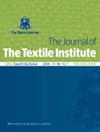喷气织机主喷嘴和各种继电器喷嘴瞬时交汇气流特性
IF 1.5
4区 工程技术
Q2 MATERIALS SCIENCE, TEXTILES
引用次数: 0
摘要
摘要针对喷气织机中单圆孔接力喷嘴引纬速度慢、纬纱运动稳定性差的问题,研究了主喷嘴与三椭圆孔接力喷嘴的瞬态交汇气流特性。采用大涡模拟(LES)方法对湍流交叉气流进行了模拟。通过将时间平均轴向速度与实验结果和reynolds -average Navier-Stokes (RANS)结果进行比较,验证了LES模型的正确性。LES仿真结果表明,单圆孔继电器喷嘴只有一个电势铁心产生约4 mm的高度,而三椭圆孔继电器喷嘴有三个电势铁心产生约4 mm的高度。采用一种新型三椭圆中心阵列继电器喷嘴,可使相交气流的平均轴向速度提高10%,波动幅度降低25%。关键词:喷气织机瞬态气流结构继电器喷嘴大涡模拟(LES)计算流体动力学(CFD)披露声明作者声明在本文的研究、作者身份和/或发表方面没有潜在的利益冲突。基金资助:国家自然科学基金(批准号:51505344,11872046),湖北省自然科学基金(2014CFB766),湖北省数字化纺织设备重点实验室开放基金(DTL202001)。本文章由计算机程序翻译,如有差异,请以英文原文为准。
Characteristics of instantaneous intersecting airflow from main nozzle and various relay nozzles in an air jet loom
AbstractDue to the low insertion speed and poor weft motion stability with single round-hole relay nozzle in the air jet loom, this study is aims to investigate the characteristics of transient intersecting airflow from a main nozzle and tri-elliptical hole relay nozzles. The turbulent intersecting airflow was simulated based on a large eddy simulations (LES). The correctness of the LES model was evaluated by comparing the time-averaged axial velocity with experimental and the Reynolds-averaged Navier–Stokes (RANS) results. The LES simulation has shown that only one potential-core arose its height about 4 mm for single round hole relay nozzle, whereas three potential-core arouse its height about 4 mm for tri-elliptical hole relay nozzles. It is possible to enhance the mean axial velocity of the intersecting airflow by up to 10% and decrease fluctuation magnitude by 25% using a new type of tri-elliptical center array relay nozzle.Keywords: Air jet loomtransient airflow structurerelay nozzlelarge eddy simulation (LES)computational fluid dynamics (CFD) Disclosure statementThe authors declared no potential conflicts of interest with respect to the research, authorship and/or publication of this article.Additional informationFundingThis work was supported by the National Science Foundation of China (Grant Nos. 51505344, 11872046), the Natural Science Foundation of Hubei Province (2014CFB766) and Hubei Digital Textile Equipment Key Laboratory Open Fund (DTL202001).
求助全文
通过发布文献求助,成功后即可免费获取论文全文。
去求助
来源期刊

Journal of the Textile Institute
工程技术-材料科学:纺织
CiteScore
4.20
自引率
5.90%
发文量
149
审稿时长
1.0 months
期刊介绍:
The Journal of The Textile Institute welcomes papers concerning research and innovation, reflecting the professional interests of the Textile Institute in science, engineering, economics, management and design related to the textile industry and the use of fibres in consumer and engineering applications. Papers may encompass anything in the range of textile activities, from fibre production through textile processes and machines, to the design, marketing and use of products. Papers may also report fundamental theoretical or experimental investigations, including materials science topics in nanotechnology and smart materials, practical or commercial industrial studies and may relate to technical, economic, aesthetic, social or historical aspects of textiles and the textile industry.
All published research articles in The Journal of The Textile Institute have undergone rigorous peer review, based on initial editor screening and anonymized refereeing by two expert referees.
 求助内容:
求助内容: 应助结果提醒方式:
应助结果提醒方式:


